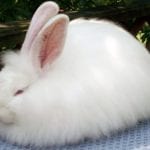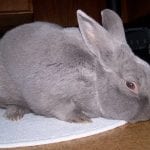Scientific Facts
| Common Name: | English spot |
| Scientific Name: | Oryctolagus cuniculus |
| Life Span: | 5 to 9 years |
| Size (Adult): | Medium |
| Weight (Adult) | 5 to 8 pounds |
| Habitat: | Human homes, gardens, yards, and farms |
| Body Shape: | Full arch |
| Country of Origin: | England |
Physical Description
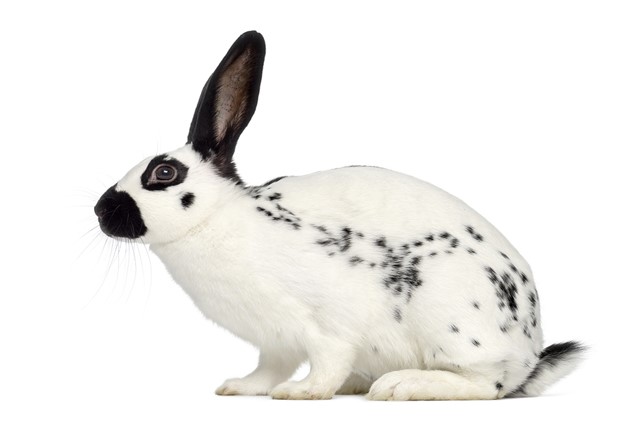
The English spot is a domesticated rabbit breed that was developed in England during the 19th century through the use of selective breeding techniques. It is a medium-sized rabbit that has an average of 5 to 8 pounds of weight.
The most notable characteristic of this breed is its colored marks on its face, body, ears, and eyes. It has a butterfly spot on its nose, dark eye circles, colored ears, cheek spots, herringbone, and other chains of spots all over its body. The ears of this rabbit breed stay erect while the hind legs are parallel to the body.
The body of the English spot is a full-arch and has long front legs that can carry the rabbit to the table. They have a curious and energetic, fun nature that will capture the hearts of rabbit owners anywhere.
Coat and colors
The English spot has a luxurious, short and dense flyback fur. This breed may shed throughout the year, but the fibers are very short, and hence, it may be impossible to notice the shedding. The evidence of shedding include clumps of hair found all over your house and inside the rabbit’s cage.
There are different colors of the English spot recognized by the ARBA or the American Rabbit Breeders Association. It recognizes black, blue, gold, chocolate, lilac, grey, chocolate, and tortoise. All the rabbits should have the classic butterfly mark, eye circles, colored ears, cheek spots, and any chain of spots along each side. There is also something called the herringbone, which is a strip of dark color that runs from the back of the neck to the tail.
History of the Breed

The English spot rabbit breed is one of the oldest fancy rabbit breeds. Until this day, the exact origin of the English spot is unknown, but some breeders say that the rabbit may have come from a breed known as the English Butterfly. This rabbit may be related to the Checkered Giant because of their common physical features like the butterfly spots, eye circles, butterflies, colored ears, cheek spots, and herringbone. The Checkered Giant is another domesticated rabbit breed that weighs 10 to 14 pounds on average.
The English spot is common in the UK since 1850, and this was introduced to North America in 1940. The first American English Spot Rabbit Club started in 1924. Meanwhile, French people named this rabbit Lapin Papillon Anglais or the English Butterfly Rabbit because of the butterfly mark on its nose. The previous generations of this rabbit breed was a white rabbit with indefinite color patches, but throughout the years, it has acquired a definite design.
Fast Facts
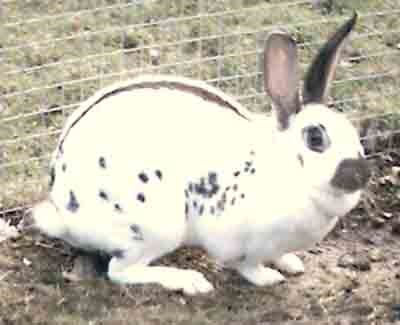
It is said that the English spot may be related to the gentle Checkered Giant, but despite the similarities in coat markings, the English spot is more energetic than its checkered parent. It is also curious and friendly, which makes it a good breed for singles, children, and first-time rabbit owners.
Reproduction
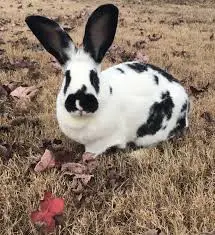
English Spots reproduce like any domesticated or fancy rabbit. It is a forced breed to get baby English Spots. Rabbits can breed all year round and begin early at 5 to 8 weeks old. For breeding success, the male is placed in his enclosure, and then after a few days, the female is introduced.
The doe will initially remain still as the male sniffs, but sometimes she will resist this gesture and escape by running inside the cage. The male will try to catch her and pin her. If she still resists, remove her from the cage and re-introduce the pair after an hour.
The female will submit to the male after some time, and she will show this by lying down and by allowing the male to sniff and mount her. Mating lasts quickly, and then you’ll know that it is successful when the male leaves the female alone. Remove the female from the cage and place her in a separate cage. The gestation period is 38 days long.
The female will look for a good place to construct her nest, and this indicates that she is about to give birth. She will refuse to eat and drink and may not be interested in socializing with other rabbits. The female will use hay and other materials nearby to line the nest. She may also use her fur.
The female will soon give birth to three to five babies. Usually, a female can become pregnant up to four times a year. She will nurse her babies and clean them, but she will soon leave her nest. The babies are blind, deaf, and naked and very vulnerable to predators.
The mother will cover her nest with hay and fur before she leaves and will only come back every night to nurse them for a few minutes. The little ones will open their eyes from 5 to 7 days and then wean from their mother’s milk from 10 to 12 days.
Personality and behavior
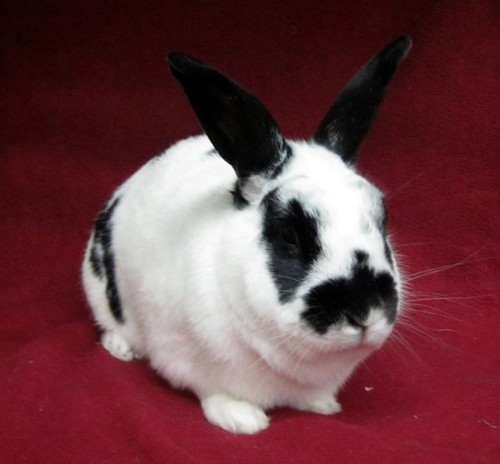
The English spot is known for its good manners and its gentle and affectionate nature. It can be trained to come to you and to eat food from your hand. Because of its many good qualities, this breed is preferred by singles, families with young children, and even seniors.
This impressive breed is a popular sight in shows. They like being handled, petted, and groomed, making them champion show rabbits and pets.
At home, you can keep an English spot in an indoor or outdoor enclosure. When kept indoors, it will need to be taken out daily and allowed to run and have fun in the sun. It is an active breed and will love to play and socialize with similar breed rabbits.
Comparable Breeds
The English spot is comparable to two rabbit breeds, namely the Checkered Giant Rabbit and the American Fuzzy Lop. It is comparable to the Checkered Giant because of their marks on the face, body, ears, and spine. This is a giant breed that weighs 11 to 13 pounds and can live up to 6 years. The Checkered Giant has semi-arch or mandolin shape with a curious, gentle, and sweet nature; these are characteristics that it shares with the English spot.
Meanwhile, the American Fuzzy Lop shares an affectionate, playful, and active behavior and temperament with the English lop. The American Fuzzy Lop is a dwarf rabbit with a compact body and weighs up to 4 pounds. It is a breed for families with children and those with small living areas.
Care of English Spots
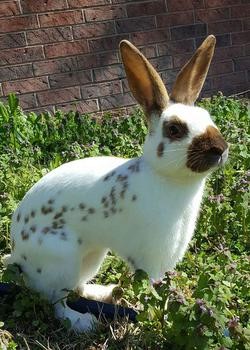
Caring for an English Spot is similar to caring for other rabbit breeds. You should consider important points like the right diet, housing, proper medical treatment, and companionship.
Rabbits need a lot of hay in their diet. This is the bulk of a rabbit’s diet, and other foods are just added to their regular meals. You can also give them rabbit pellets, which are commercially-prepared food with vitamins and minerals for your rabbit’s good health. You may also provide vegetables and fruits for a healthy, well-balanced rabbit diet.
Always keep unlimited fresh water and hay. The reason why hay is important is that it can help keep their digestive tracts regular. Hay also keeps the rabbit’s teeth trimmed and short. An inverted water bottle with a spout ais also a good spill-proof way to drink for rabbits.
Your pet should consume the right food. Avoid food with pesticides, toxins, and herbicides and feed it organic fruits and vegetables. Younger rabbits require alfalfa hay because this is rich in calcium needed for growing bones. On the other hand, adult English Spots may eat legume hay.
Captive-bred rabbits can become calm and friendly when you handle and interact with it when it is still young. Rabbits are social animals and will need companions aside from playing with their owners. Rabbits with constant companions and have interactions with their owners are healthier, happier, and easier to handle than other rabbits.
English Spots are meticulous groomers and will groom themselves for many hours. Rabbits also groom each other because of this, a way to bond with other rabbits. Also, mother rabbits groom her kits when she is still in her nest.
English Spots are very active in the daytime and sleep in the evenings. Therefore, feeding your pet English Spot and cleaning its cage should be done in the morning when they are more active. Also, rabbits can sleep up to 8 hours a day with several naps in between. These animals and may sleep huddled closely to keep themselves warm.
Supplies and Cages
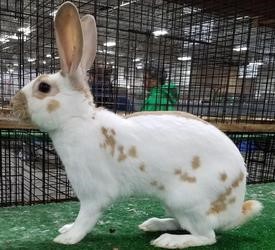
Young English Spot rabbits are very energetic, and therefore, you need a big enclosure where your pets can run and play. This should be made of wire and have a very strong frame. The bottom part should be removable, and this is where the rabbit’s droppings will fall. The removable pan makes it easy to dispose of the rabbit’s droppings. The floor of the enclosure should have soft bedding and have soft and warm cage bedding.
Place a rabbit hay feeder on the side of the enclosure and put the hay inside. Your rabbit can eat when it is hungry by just taking some from the feeder. For the cage, bedding, hay, wood pellets, or horse bedding would be perfect.
To clean the rabbit’s cage, remove your pets and place them in a safe and clean container or cage. A safe cleaner or cleaning product like white vinegar, baking soda, or lemon juice would suffice. Never use household cleaners because these could contain dangerous ingredients that can affect your pet’s health.
You must have a separate or extra cage if you want to take care of baby rabbits. Babies are usually born naked, deaf, and blind and, therefore, must be placed in a warm and safe enclosure to keep the best temperatures.
English Spots will love chewing on anything it can place its furry paws on. If you are planning to keep these rabbits indoors, these will chew on anything made of wood and other light materials. It may also chew on electrical wiring and wander around dangerous parts of your home or yard. To avoid any accident, provide hay or chew toys inside its cage. You must rabbit-proof your home before releasing your rabbits from their cage.
Health Concerns
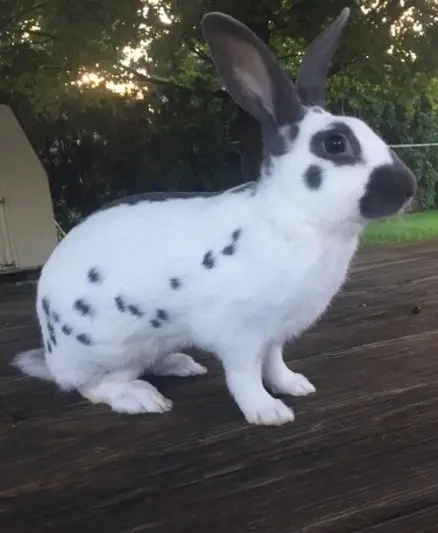
An English Spot is a healthy breed and usually, are not affected by any particular disease. The most common condition that the English Spot may be affected with are pests like mites, ticks, and fleas. These pests are usually hard to avoid since these are naturally found in their environment.
English Spots are not immune to common rabbit diseases. This is the reason why you must always monitor your rabbit’s health and behavior. Any changes could be due to an illness. And as early as your pet opens its eyes and weans from its mother, take it to the vet for tests and vaccinations.
The vet will assess the overall health and development of your rabbit. He will also rule out conditions like enteritis, bloat, and stasis, which mostly affect rabbits that are less than two months of age.
Watch out for ear or fur parasites, and the most common ones are mites, fleas, and ticks. Rabbits that have these parasites have poor hygiene and are housed in dirty enclosures and surroundings. Also, a new rabbit may introduce these pests to your cage, and this is why some pet owners prefer to quarantine new pets before introducing them to the main cage.
Also, monitor your rabbit for any signs of illness such as poor appetite, nasal and eye discharges, constipation, loose stools, and vomiting. Also, rabbits with an unsteady gait, restlessness, teeth grating, and sleeping for longer hours may have a serious medical condition.
You must never forget to deworm your pets. This is an important part of caring for rabbits and other pets. An English Spot must be treated for worms at least twice a year and must be done during springtime and fall. Rabbits that are from the wild or from wild parents and those that are kept outdoors are more vulnerable to worms.
All rabbit breeds may use a deworming paste. Use a pea-sized deworming paste and place this in the rabbit’s mouth, and this will lick and swallow the medication until it is gone. Follow your vet’s advice when it comes to deworming.
Dental Care
A rabbit’s teeth will grow continuously, and sometimes the tooth may grow extensively, and it can pierce their mouth and gums. This can lead to pain and discomfort. Make sure that the rabbit’s teeth don’t overgrow to avoid pain and stress.
Offer hay because this can grind the rabbit’s teeth as it chews. You may also place blocks of wood, small wooden baskets, or other toys that the rabbit can chew on to file its teeth. If it’s too late and your rabbit’s teeth have overgrown, visit a vet who will file the teeth for you. Monitor your rabbit’s dental health to save on expensive dental bills.
Spaying or Neutering
Rabbits are naturally promiscuous, and therefore, you must control this by spaying or neutering. Spaying and neutering should be done while the rabbit is still young. Some vets prefer to wait until the rabbits are six months old but some neuter English Spot bucks at a young age. They recommend this to reduce aggression.
Some vets neuter bucks at three months while some may wait longer. For any question about spaying and neutering, consult your vet.
Grooming
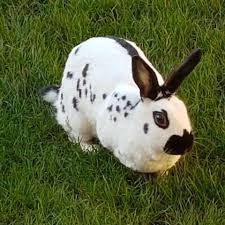
English Spots have short furs, but no matter what coat your rabbit has, it will need regular grooming. Use a strong, easy to handle brush to keep the fur clean, shiny, and free from pests. Groom this at least once or twice a week.
Grooming should also be done more frequently during the rabbit’s molting period. Molting is the time when the rabbit loses all its old fur to make room for new fur. Depending on the breed, molting can happen once, twice, or even more in a year, And prevent wool blocks and to keep the rabbit from eating their fur groom your pet regularly and more during the molting periods.
If your English Spot is very dirty, never bath it because this can cause a lot off stress. Instead, use a damp towel to spot clean it. Just wipe the rabbit down with the towel and use a dry one afterward. And don’t forget to trim your rabbit’s nails monthly and check its ears and its mouth for overgrown teeth.
Availability – Where to Get One?
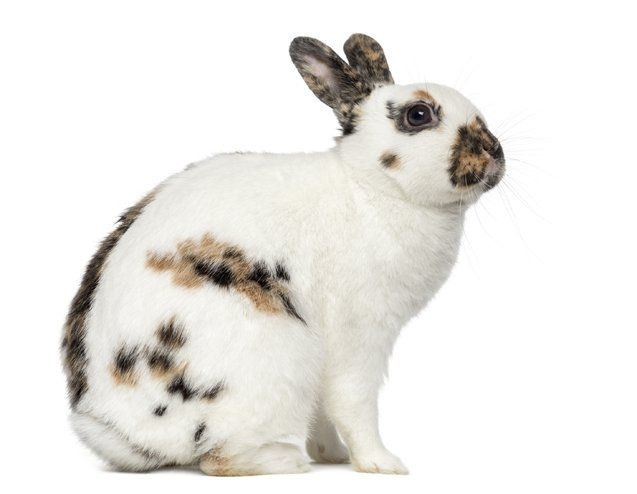
You can buy an English Spot from a breeder or a retailer. The price will vary whether you are purchasing a pet or a show rabbit. You can expect the price to change according to the rabbit’s gender, size, coat quality, coat color, and overall appearance. Buying online is also more expensive since you need to pay for delivery and shipment fees.
If you are looking for a reliable breeder, select one that breeds healthy English Spots that have no genetic disorders. Buy only from reliable breeders. You can also find English Spot breeders in trade fairs and farm events. There are also shows that are sponsored by the ARBA, which showcase the English Spot and other impressive rabbit breeds.
How to Care for an English Spot
This is a summary of how to care for an English Spot breed. Caring is just like any other rabbit breeds. Remember the four: the correct diet, housing, companionship, and vet care.
When it comes to a correct diet, the staple food of captive-bred rabbits is hay. This is very important to grind their continuously-growing teeth, keep their digestive system healthy, and maintain regular bowel movements. Provide quality rabbit pellets because this comes with added nutrients. Offer vegetables and fruits for a well-rounded diet. You may also give them food a rabbit’s natural habitat, such as grasses, twigs, seeds, and weeds, to name a few but make sure that these are from organic sources.
And no matter what, keep water and hay inside the rabbit’s cage. Replace water twice a day and place it in a large, heavy, and shallow dish so that your rabbit can drink from it without spilling.
Captive-bred rabbits such as the English Spot can only become a calm, friendly, and docile pet when you take time to train and bond daily. Captive rabbits are social animals and will need a rabbit companion or more companions.
Be sure to have the time, space, and resources to care for more rabbits. If you can’t spare these, then you might be better off with another pet. Your pet will grow healthy and develop a good temperament and a docile behavior when it socializes with you and his companions.
Finally, take your pet to the vet early because it needs vaccinations and tests. This must be given a clean bill of health before you can take it home and be with other rabbits, other pets and with people. You should learn the different signs of illness and consult a vet as early as possible.
FAQs
Will English Spots eat their droppings?
Yes, the English spot will eat its dropping just like all rabbit breeds, and it will do so because it still has nutrients in them. But after eating its poop once, it will never eat it again because it’s very dry, and this means it has already digested the nutrients.
Should you rescue a wild rabbit from the forest?
No, never pick a wild animal such as rabbit from the forest. This rabbit will be very difficult to train, and therefore, you can’t take it as a pet. For an injured wild rabbit or to rescue rabbits in the wild, call animal services for help.
Are English Spots endangered?
No, English Spots are not endangered. This is a domesticated rabbit and hence is available from local and international breeders and in pet shops and human homes as pets.
How do you tame a rabbit?
A wild rabbit cannot be tamed because you might end up getting hurt. You may train a captive-bred rabbit instead because these rabbits have a docile behavior and are friendlier than their wild cousins.
What do English Spots eat?
English Spots are herbivorous, and they will eat only plants. These will eat all parts of the plant like roots, bark, seeds, weeds, flowers, and leaves. In captivity, it can eat rabbit food, vegetables, seeds, and fruits.
Will English Spots eat fruits and vegetables?
Yes, English Spots will eat fruits and vegetables, but aside from these, you may also feed your pets commercially-prepared pellets or rabbit food, which contains nutrients for his good health.
Can you keep an English Spot as your pet?
You can keep the English Spot as a pet because it is docile and behaved. This is a good pet for families and also for families with children, but take note that space is very important since English Spots are active.
Are English Spots carnivorous rabbits?
No, these rabbits are not carnivorous. These are herbivores, which means that these will consume plants or plant parts like roots, bark, leaves, flowers, twigs, stems, seeds, and so much more.
Can you keep two or more English Spots in one cage?
You can keep two or more English Spots as long as you have a large cage. The cage should be spacious, comfortable, and safe so that your rabbits can remain secure.
Can English Spots swim?
Yes, English Spots may know how-to, but it may not be as good as rabbits that are used in water. But most rabbits do not want to get wet and will not like a bath because this is stressful for them.
How do you clean an English Spot’s cage?
Initially, remove the rabbit inside the cage and place it in a separate cage. Remove the pan under the cage and dispose of the droppings. Hose the cage down and use a brush. Use a cleaning product and clean the cage walls, bottom, cage accessories, and toys. Replace the cage bedding and make sure that everything is dry before putting your pet back inside.
Where do you place an English Spot’s cage, indoors, or outdoors?
This may depend on your preference. You may place the cage indoors to shield your pet rabbits from the sun, rain, and the cold, but your pet will have a limited space to play and may not be enough to house a large, adult English Spot. When the cage is outdoors, the rabbits may have to deal with the elements, but at least they will have a large area to move around.
Where do English Spots live?
English Spots are not found in the wild because these are domesticated rabbits. English Spots are found in human and commercial areas such as kennels, pet stores, and human homes as pets. Ass pets, these may be housed in large indoor or outdoor cages, preferably in groups for companionship.
How do you deal with baby English Spots?
If care for baby English Spots, put the kits in a comfortable and warm enclosure to serve as their nest. Feed baby rabbits soft pureed food and keep these safe and warm. Protect from predators nearby like your cat or pet dog. But for wild-caught rabbits, don’t move them and just call animal services for having these rescue.
Do you need to use a heater inside a rabbit’s cage?
You may use a cage lamp instead of a heater to provide heat. But in cold climates, use a small portable heater and place this near the cage to make a warm and comfortable place for your pets. This is an ideal setup for taking care of incubating kits.
Will a mother English Spot eat her babies?
There are rabbit species that can eat their babies, and if you see a mother English Spot eating her young, remove it from the litter or nest and never allow it to breed again.
Does it hurt when an English Spot scratches you?
Yes, the scratch of an English Spot will hurt. Despite having a docile nature, it has sharp claws on its hind feet. This rabbit can kick hard with its hind feet, as well. English Spots will only do this when it feels threatened.
How large should an English Spot’s cage be?
An English Spot is a medium-sized rabbit and must be placed in a large enclosure. For a cage for two large rabbits, double the area for a single rabbit. You must never overlook the cage size and make sure that your rabbits have space to play, eat, and sleep. Also, always consider the number of rabbits that will use the enclosure to get the perfect cage size.
Are English Spots bites dangerous?
Yes, English Spot bites can be very dangerous because the species may have rabies. Rabbit teeth may also be very long, and this can easily tear off skin and flesh, leading to a deep wound.
Can rabbits see well in the dark?
Yes, rabbits have good vision, and even during nighttime, they can see very well. This is why some species prefer to forage for food even at night. Rabbits such as the English Spot have good smell and hearing, which allows them to feel for any predators in their area.
Can you leave English Spots indoors?
You may let a rabbit stay indoors, but this is under your constant supervision. If you need to leave your pet alone, use a portable fence to keep it off areas in your home. Rabbit-proof your home if you plan to do this regularly.
Will English Spots recognize their owners?
Some rabbit owners say that their English Spots rabbit can recognize them and can tell if they are being held by their owners or by a stranger. Their pets start to become skittish in the hands of strangers because they know they are not being held by their owners.
Are English Spots territorial?
Not really, but if placed in a very small cage with other rabbits, then territorial behaviors may arise. Males can develop aggressive behavior and may become very dangerous, especially during the breeding season. The aggressive males can bite, scratch, and kick other males in the cage to fight for hierarchy.
Can English Spots escape their cages?
Yes, English Spots can escape their cages by kicking these down. These may also jump over and escape, especially if the cage walls are too short and may also use force if necessary to escape.
Can you prevent an English Spot from eating his droppings?
You can stop an English Spot from eating his poop by removing the droppings after these have defecated. But no matter what, these will still eat their droppings because they know it still has nutrients. These won’t eat poop with a hard texture because this means that it is no more nutrients in them.
Can rabbit diseases affect humans?
Some rabbit diseases affect rabbits only while some may be transferred to humans. And if your rabbit is sick, take it to the vet at once. Understand the different signs of illnesses such as lack of appetite, loose stools, constipation, problems with breathing, and any change in behavior. Take your pet to the vet as soon as you notice these signs.
Do English Spots have good hearing?
The English Spot has good hearing. It can hear predators from far away, and this gives it time to escape any kind of threat.
Can you train a rabbit to walk with a collar and leash?
Some pet owners can train their pet rabbits to wear a collar and a leash, but some are not too successful. This may be due to the temperament of each rabbit and may depend on what breed of rabbit you are training.
What happens when the teeth of a rabbit become longer?
When the teeth of the rabbit become longer, this can pierce its mouth and gums, and this can lead to pain and poor appetite. Take your rabbit to the vet and dentist regularly and help it by feeding it hay since this can grind their teeth t as the rabbit chews.
How often do you visit the vet?
Rabbits must visit the vet twice a year. Young rabbits should visit the vet to get vaccinated against diseases as early as possible. These should have an initial visit to a vet when they are just a few weeks old.
How old should a rabbit be to get spayed or neutered?
It depends on the vet as to when to do this. Some bucks are neutered at 3 months, while some vets will wait till these are 5 to 6 months.
How many rabbits are enough as pets?
You can keep three, four, or more as long as you have a large cage to keep all your pets comfortable and happy. Keeping only one rabbit will make it lonely, and this may affect its health.
Will rabbits eat insects and bugs?
No, rabbits won’t eat insects because these are herbivores and thus will eat only plant and plant parts, rabbit pellets, fruits, and vegetables. When feeding your rabbit fruits and vegetables, be sure that these are organic to avoid pesticides, toxins, and chemicals that can harm your pet.
Where do rabbits sleep in the wild?
In the wild, rabbits can sleep in warrens; these are holes or burrows that they have constructed. Rabbits can dig deep holes and make tunnels and chambers. Rabbits can sleep and spend many hours in their dens and nests. In captivity, they live in an enclosure that can accommodate a group of rabbits. This is safe and secure from predators.
Can pet rabbits be tolerant of young children?
Some rabbits don’t want to be held, especially by young children, because children have small and unsteady hands. Meanwhile, some rabbits are calm, docile, and friendly and will be okay when held and petted even by young children.
Will your pet rabbit handle the cold?
Some pet rabbits can tolerate the cold and will find it fun to play, especially in the snow. Some rabbits can change their coat color to adapt to the cold climate while some may not survive the cold like rabbits breeds in the desert.
Can you place the cage of English Spots near other breeds?
Yes, you can because there’s nothing to worry about if the cage of an English Spot is near other breeds because this breed is very friendly, docile and calm.
How do you deal with abandoned baby rabbits?
If wild kits are abandoned in their nests, call animal service to help these wild rabbits. You should never get baby rabbits from the wild to take care of as pets.
Can rabbits deal with a cold climate?
Yes, rabbits can stay in a cold area and survive by looking for food that’s under the snow. Rabbits will use their legs to dig out food under the snow; they use their keen sense of smell to find food even deep into the snow.
Can English Spots stay outdoors?
A pet English Spot may stay outdoors, but you must rabbit-proof your yard or outdoor area first. Portable fencing is a safe way to limit the area where the rabbit can roam around. Bury the fence poles to prevent the rabbit from digging and escaping.
Are all female rabbits cannibals?
Eating their young is observed in some female rabbits, and breeders say that this happens because the female is hungry or thirsty, and there’s no food or water in the cage. Also, some say that rabbits do this in the wild to remove any traces of tissue, blood, and smell of stillborn babies in the nest to safely keep kittens in the nest.
